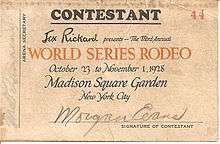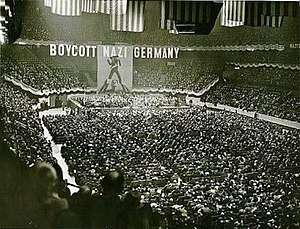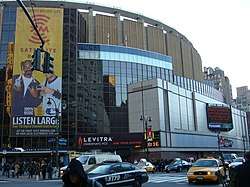Madison Square Garden (1925)
Madison Square Garden (MSG III) was an indoor arena in New York City, the third bearing that name. It was built in 1925 and closed in 1968, and was located on the west side of Eighth Avenue between 49th and 50th Streets in Manhattan, on the site of the city's trolley-car barns.[1] It was the first Garden that was not located near Madison Square. MSG III was the home of the New York Rangers of the National Hockey League and the New York Knicks of the National Basketball Association, and also hosted numerous boxing matches, the Millrose Games, concerts, and other events.
 hand-colored postcard | |
%26groups%3D_1eccba9766505eb745584e7b4490094f77698d01.svg)
| |
| Full name | Madison Square Garden |
|---|---|
| Location | Manhattan, New York |
| Coordinates | 40.7624°N 73.9877°W |
| Owner | Tex Rickard |
| Operator | Tex Rickard |
| Capacity | Basketball: 18,496 Ice hockey: 15,925 |
| Construction | |
| Broke ground | January 9, 1925 |
| Opened | December 15, 1925 |
| Closed | February 11, 1968 |
| Demolished | 1968–1969 |
| Architect | Thomas W. Lamb |
| Tenants | |
| New York/Brooklyn Americans (NHL) (1925–1942) New York Rangers (NHL) (1926–1968) St. John's Red Storm (NCAA) (1930s–1968) National Invitation Tournament (1938–1967) New York Knicks (BAA/NBA) (1946–1968) | |
Groundbreaking
Groundbreaking on the third Madison Square Garden took place on January 9, 1925.[1] Designed by the noted theater architect Thomas W. Lamb, it was built at the cost of $4.75 million in 349 days by boxing promoter Tex Rickard, who assembled backers he called his "600 millionaires" to fund the project.[1] The new arena was dubbed "The House That Tex Built."[2] In contrast to the ornate towers of Stanford White's second Garden, the exterior of MSG III was a simple box. Its most distinctive feature was the ornate marquee above the main entrance, with its seemingly endless abbreviations (Tomw., V/S, Rgrs, Tonite, Thru, etc.) Even the name of the arena was abbreviated, to "Madison Sq. Garden".
The arena, which opened on December 15, 1925, was 200 feet (61 m) by 375 feet (114 m), with seating on three levels, and a maximum capacity of 18,496 spectators for boxing.[1] It had poor sight lines, especially for hockey, and fans sitting virtually anywhere behind the first row of the side balcony could count on having some portion of the ice obstructed. The fact that there was poor ventilation and that smoking was permitted often led to a haze in the upper portions of the Garden.
In its history, Madison Square Garden III was managed by Rickard, John S. Hammond, William F. Carey, General John Reed Kilpatrick, Ned Irish and Irving Mitchell Felt.[1] It was eventually replaced by the current Madison Square Garden.
Events
Sports

Boxing
Boxing was Madison Square Garden III's principal claim to fame. The first bout took place on December 8, 1925, a week before the arena's official opening. On January 17, 1941, 23,190 people witnessed Fritzie Zivic's successful welterweight title defense against Henry Armstrong, still the largest crowd for any of the Gardens.[3]
Hockey
The New York Rangers, owned by the Garden's owner Tex Rickard, got their name from a play on words involving his name: Tex's Rangers. However, the Rangers were not the first NHL team to play at the Garden; the New York Americans had begun play in 1925 – and in fact, officially opened the Garden by losing to the Montreal Canadiens, 3-1[1] – and were so tremendously successful at the gate that Rickard wanted his own team as well. The Rangers were founded in 1926, playing their first game in the Garden on November 16, 1926,[1] and both teams played at the Garden until the Americans suspended operations in 1942 due to World War II. In the meantime, the Rangers had usurped the Americans' commercial success with their own success on the ice, winning three Stanley Cups between 1928 and 1940. The refusal of the Garden's management to allow the resurrection of the Americans after the war was one of the popular theories underlying the Curse of 1940, which supposedly prevented the Rangers from winning the Stanley Cup again until 1994. Another alleged cause of "The Curse" stemmed from then-manager Kilpatrick burning the Garden's mortgage papers in the bowl of the Stanley Cup, as receipts from the 1940 Cup run had allowed the MSG Corporation to pay it off: hockey purists believed that the trophy had been "defiled", thus leading to the Rangers' woes.
The New York Rovers, a farm team of the Rangers, also played in the Garden on Sunday afternoons, while the Rangers played on Wednesday and Sunday nights.[1] Tommy Lockhart managed the Rovers games and introduced on-ice promotions such as racing model aircraft and bicycles around the arena, figure skating acts Shipstads & Johnson Ice Follies and Sonja Henie, and a skating grizzly bear.[4]
Basketball
The first professional basketball game was played in the 50th Street Garden on December 6, 1925, nine days before the arena officially opened. It pitted the Original Celtics against the Washington Palace Five; the Celtics won 35-31.[1] The New York Knicks debuted there in 1946, although if there was an important college game, they played in the 69th Regiment Armory.[1] Thanks to other events being booked in the arena, all their home games during the 1951, 1952 and 1953 NBA Finals were played at the Armory; thus MSG III never hosted an NBA Finals game. MSG III also hosted the NBA All-Star Game in 1954, 1955 and 1968.
In 1931, a college basketball triple header to raise money for Mayor Jimmy Walker's Unemployment Relief Fund was highly successful. In 1934, Ned Irish began promoting a successful series of college basketball double headers at the Garden featuring a mix of local and national schools. MSG III began hosting the National Invitation Tournament annually in 1938, and hosted seven NCAA men's basketball championship finals between 1943 and 1950. On February 28, 1940, Madison Square Garden hosted the first televised basketball games in a Fordham-Pitt and Georgetown-NYU doubleheader. A point shaving scandal involving games played at the Garden led the NCAA to reduce its use of the Garden, and caused some schools, including 1950 NCAA and NIT Champion City College of New York (CCNY), to be banned from playing at the Garden.[5]
Professional wrestling
Capitol Wrestling Corporation—along with its successor, the World Wide Wrestling Federation—promoted professional wrestling at the Garden during its last two decades. Toots Mondt and Jess McMahon owned CWC, which initially promoted tag team wrestling. Throughout the 1950s and 1960s, Mondt and McMahon were successful at promoting ethnic heroes of Puerto Rican or Italian descent.
Two especially notable events in wrestling history took place at MSG III. On May 17, 1963, Bruno Sammartino defeated "Nature Boy" Buddy Rogers, via submission, in 48 seconds, to become the second ever WWWF World Heavyweight Champion. On November 19, 1957, the Dr. Jerry Graham & Dick the Bruiser vs. Edouard Carpentier & Argentina Rocca main event led to a race riot involving the largely Italian and Puerto Rican fans of Carpentier and Rocca. After the riot, New York City nearly banned professional wrestling and children under the age of 14 were prohibited from attending.[6]
Cycling
From 1925 until 1961, Madison Square Garden hosted the Six Days of New York, an annual six-day racing event of track cycling. Upon its final running, it was the longest-running six days in the world with 73 editions.
Other entertainment
The Circus
While the Ringling Bros. and Barnum & Bailey Circus had debuted at the second Garden in 1919, the third Garden saw large numbers of performances. The circus was so important to the Garden that when the Rangers played in the 1928 Stanley Cup Finals, the team was forced to play all games on the road, which did not prevent the Rangers from winning the series. The circus would continue to perform as often as three times daily throughout the life of the third Garden, repeatedly knocking the Rangers out of the Garden at playoff time.[7]
The circus acrobatics included acts in the rings as well as on the high wire and trapeze. One dramatic act which was only performed in the Garden, and not taken on the road with the traveling circus, involved Blinc Candlin, a Hudson, New York fireman, who rode his antique 1880s high-wheel bicycle on the high wire every season for over two decades beginning in the 1910s and running well through the 1930s.
Dog Show
The Garden continued to host The Westminster Kennel Club's annual dog show. This championship is the second longest continuously running U.S. sporting event (behind only the Kentucky Derby).
Notable events

- The very first event held at the third Garden was a bicycle race held from November 24 to the 29th, several weeks before the official opening of the arena.
- Although MSG III never hosted a national political convention (see below), in 1932 Franklin Delano Roosevelt continued a tradition begun in 1892 by Grover Cleveland when 22,000 people came to a rally held to support him in his bid for the U.S. presidency.[1] In 1936, Roosevelt delivered his last campaign speech before that year's election there.
- On March 15, 1937, a massive "Boycott Nazi Germany" rally was held in the Garden, sponsored by the American Jewish Congress and the Jewish Labor Committee. John L. Lewis of the Congress of Industrial Organizations and New York City mayor Fiorello LaGuardia were among the speakers.[8]
- Ice skater and film star Sonia Henie brought her Hollywood Ice Review to the Garden in 1938, drawing more than 15,000 fans.[1]
- On February 20, 1939, a pro-Nazi organization called German American Bund held a rally with 20,000 in attendance at the third Madison Square Garden. By December 1941, the U.S. government outlawed the group.
- In 1957, evangelist Billy Graham had a New York City mission at the Garden, which ran nightly for 16 weeks.
- In 1940, 13,000 people attended the rodeo, featuring Gene Autry.[1]
- Elizabeth Taylor was the host when Hollywood producer Mike Todd held an anniversary party for his film Around the World in 80 Days on October 17, 1957, featuring Marilyn Monroe riding an elephant.[1]
- Monroe also memorably sang Happy Birthday to You to President John F. Kennedy at his birthday party at the Garden in May 1962.[1]
- In the early 1960s, MSG III was the site of the Daily News Jazz Festival.[9]
Demolition
Demolition commenced in 1968 after the opening of the fourth and current Madison Square Garden. It finished in early 1969. When the third Madison Square Garden was torn down, there was a proposal to build the world's tallest building on the site, prompting a major battle in the Hell's Kitchen neighborhood where it was located. Ultimately, the debate resulted in strict height restrictions in the area. The space remained a parking lot until 1989 when Worldwide Plaza, designed by David Childs of Skidmore, Owings and Merrill, opened on the site of the old Garden and French Polyclinic Hospital across the street.
Cultural references
- The Hollywood movie Rhythm on the Range starring Bing Crosby was filmed in part at MSGIII during the 1935 rodeo.
- One type of event that was never held in the 50th Street Garden was a national Democratic or Republican nominating convention, as neither party met in New York to select their candidates for U.S. president and vice president between 1924 and 1976. Despite this, some of the climactic scenes of the thriller film The Manchurian Candidate (1962), in which a brainwashed assassin attempts to kill a presidential nominee at a convention, was filmed at the third Garden.
- MSG III was featured prominently in the story of Ron Howard's film Cinderella Man (2005), although exterior montage shots glorified it by placing it against the Times Square signs on Broadway, when in fact the building was one block west.
- Several Warner Bros. cartoons referred to the arena as "Madison Round Garden", and the Popeye cartoon Brotherly Love referred to the Garden as "Patterson Square Garden."
- A 1958 episode entitled "Rodeo" of the CBS crime drama television series, Richard Diamond, Private Detective, starring David Janssen, is a dramatization of the murder of a rodeo performer, Ed Murdock, played by Lee Van Cleef, who seeks to reclaim the top prize at Madison Square Garden before he retires to an isolated ranch. His wife, Marcy (Barbara Baxley) conspires with Charles Decker (Harry Lauter) to have him murdered and to frame another rodeo performer for the crime. Dan Blocker appears in the episode as Cloudy Sims, still another rodeo performer.[10]
See also
References
- "Madison Square Garden III" on Ballparks.com
- Schumach, Murray (February 14, 1968).Next and Last Attraction at Old Madison Square Garden to Be Wreckers' Ball, The New York Times
- Baker, Mark A. (2019). Between the Ropes at Madison Square Garden, The History of an Iconic Boxing Ring, 1925-2007. ISBN 978-1476671833.
- Miller, Chuck. "FROM ATLANTIC CITY TO TORONTO: The Boardwalk Trophy and the Eastern Hockey League" (PDF). Hockey Ink!. Retrieved April 16, 2018.
- Nat Holman: The Man, His Legacy and CCNY."The 1951 Basketball Scandal" Archived December 5, 2007, at the Wayback Machine - The City College Library - City College of New York.
- "Wrestling Observer Newsletter, February 3, 1997". Wrestling Observer Newsletter. Retrieved April 10, 2014.
- Even at the fourth Garden, games would sometimes have to begin as late as 9:00 p.m. to accommodate the circus.
- "From Haven to Home" Library of Congress exhibit.
- Billboard Music Week, March 13, 1961. "Daily News Jazz Festival, June 8-9"
- ""Rodeo", Richard Diamond, Private Detective, February 20, 1958". Internet Movie Data Base. Retrieved March 30, 2013.
External links
| Preceded by Barton Street Arena |
Home of the New York Americans 1925–1942 |
Succeeded by last arena |
| Preceded by First arena |
Home of the New York Rangers 1926–1968 |
Succeeded by Madison Square Garden |
| Preceded by First arena |
Home of the New York Knicks 1946–1968 |
Succeeded by Madison Square Garden |


